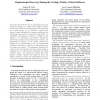Free Online Productivity Tools
i2Speak
i2Symbol
i2OCR
iTex2Img
iWeb2Print
iWeb2Shot
i2Type
iPdf2Split
iPdf2Merge
i2Bopomofo
i2Arabic
i2Style
i2Image
i2PDF
iLatex2Rtf
Sci2ools
ICSE
2003
IEEE-ACM
2003
IEEE-ACM
Requirements Discovery during the Testing of Safety-Critical Software
This paper describes the role of requirements discovery during the testing of a safety-critical software system. Analysis of problem reports generated by the integration and system testing of an embedded, safety-critical software system identified four common mechanisms for requirements discovery and resolution during testing: (1) Incomplete requirements, resolved by changes to the software, (2) Unexpected requirements interactions, resolved by changes to the operational procedures, (3) Requirements confusion by the testers, resolved by changes to the documentation, and (4) Requirements confusion by the testers, resolved by a determination that no change was needed. The experience reported here confirms that requirements discovery during testing is frequently due to communication difficulties and subtle interface issues. The results also suggest that "false positive" problem reports from testing (in which the software behaves correctly but unexpectedly) provide a rich source...
| Added | 09 Dec 2009 |
| Updated | 09 Dec 2009 |
| Type | Conference |
| Year | 2003 |
| Where | ICSE |
| Authors | Robyn R. Lutz, Ines Carmen Mikulski |
Comments (0)

